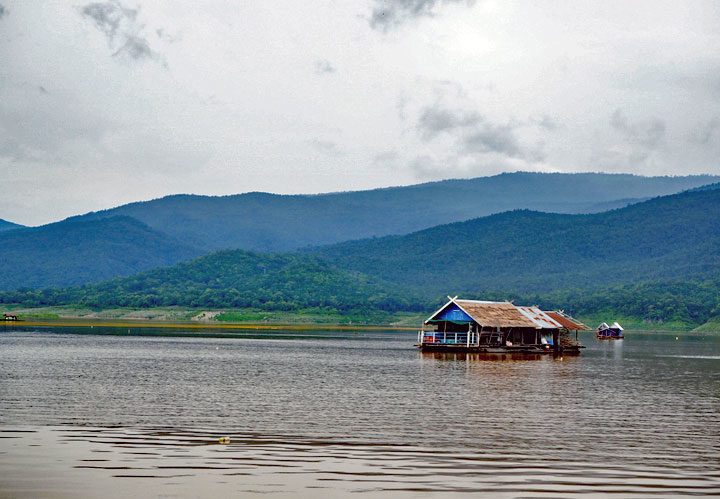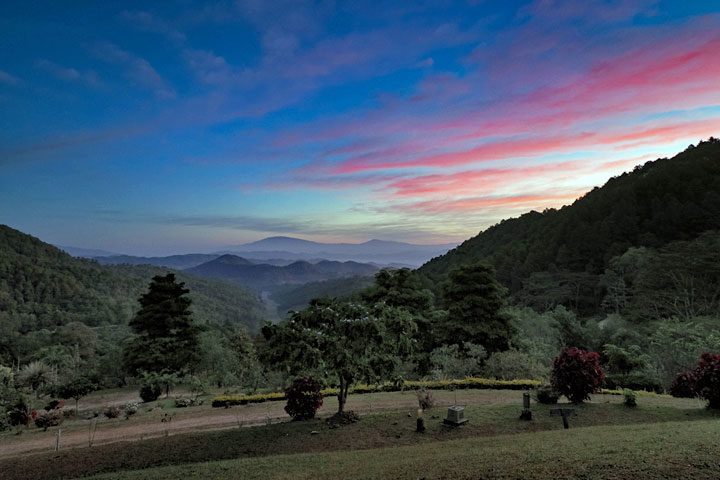The Hot district in Chiang Mai is 'cool'

Ob Luang National Park
The 'Hot District' can be found in the province Chiang Mai, south of Hang Dong. It is easy to reach from the city of Chiang Mai and is certainly worth a (day) trip.
On your way via Highway 108 you can start with a visit to the village Ban Rai Phai Ngam, which is 4 kilometers from the main road. The village is known for its high-quality hand-woven cotton. The local weavers often gather in the house of the late Saengda Bansit, a nationally renowned artist who took the initiative to extract dyes from natural materials. The unique canvas is really worth a stop.
Continue on Highway 108 to the end and turn left onto Highway 1130. This will take you to the artificial Two Taos lake, where you can cool your feet in the water or even take a dip, renting a boat or rafting is also possible. Doi Tao Lake is part of Ob Luang National Park, and was created for the Bhumibol Dam in Tak Province.

Doi Tao more
Ob Luang gorge
Ob Luang National Park is famous for the Ob Luang gorge, surrounded by teak forests and mountains, through which a small stream flows cascading. In the rainy season this small stream can turn into a raging body of water and the canyon itself is good for mysterious echoes. Visitors can get from one side of the gorge to the other via a small narrow bridge, but those with a fear of heights will find it difficult. Nearby hot springs provide a refreshing foot bath for hikers.

Mae Tho National Park
Another beautiful park to visit, also accessible from Highway 108 is the Mae Tho National Park. The park is about 160 miles from Chiang Mai, past Ob Luang National Park to Highway 1270 and then north. The road to the park is unpaved and leads through deep ravines and mountain slopes, a car in good condition and a strong heart is recommended. But the result may be there. The landscape is beautiful, impressive waterfalls and the viewpoint at Doi Mae Tho is famous for a great view over the Karen highland rice fields. The highest point in that mountain range (1699 meters) is Doi Gew Rai Hmong near Baan Paang Hin-Fon.


I will never forget Hot.
Once I was with a friend and asked someone the way to Hot in the time when there was no internet. Hot, hot, hot in every pitch I could think of but no light came on. Friend also tried all tones and finally it came through. Hot was 10 km away but I still wonder why someone can't understand the intent of a language but then again there are millions who pronounce the R as L. Not wanting to be able or wanting to understand is hiding a lack of IQ and I think there are plenty of studies into that.
In terms of pronunciation there is little that can be done wrong, the name is ฮอด (h-oh-d) or simply 'hot' pronounced in a mid tone. The vowel length is also clear, an 'oh', so there is little that can be done wrong with that. A stroke of luck because English spelling often turns long vowels into short ones: โรง is then rong instead of 'roong', the well-known place นาน is then Nan instead of 'Naan', etc.
At most I can imagine that the context was not clear: hot what? How what? Who, what's hot? A person, shop, hotel? อำเภอฮอด, ampheu hot (district hot) should be clear. But then you might as well immediately ask in Thai: “ampheu hot yoe thie nai (na khrap)”: where is the district hot? Even with a few slightly wrong tones and vowel lengths, it should be understandable, I think. Of course, first make friendly contact: “sorry sir, can you help me?” Or “hello there” or something, out of the blue “hey, where is..?” Of course, you don't shout with strangers. Unless someone has “an IQ problem”??
Internet can sometimes fail, but for those who live more or less in Thailand, learning to read Thai is useful. Then you just read the place names in Thai. For example, with the Dutch-Thai spelling & grammar booklet from our Ronald Schütte. 🙂
Rob, ฮอด Hot starts with a low class consonant -h- then a (very) long vowel -oh- and finally a soft -t-. The latter means that it is a 'dead' syllable. So it has a falling tone and no middle tone. If you pronounce it like the English 'hot', no Thai will understand what you mean.
Thank you for the explanation Tino. We only knew English 'hot'.
Oops, thanks Tino. Stupid of me, yes is of course a dead and not a living syllable, so no middle but falling tone (as in a command: YES! NO!). In English the O is very short, it does not resemble the 'oh' sound. So indeed don't pronounce it the English way... although the English spelling (hot) does give that suggestion due to the loss of both vowel length and tone..
Phonetically better written as hôht (where the T at the end is half gone, so no emphatic T or D sounds at the end).
When pronunciating syllables, it must also be taken into account that the last consonant is often not completed. So when hot, the front of the tongue should remain against the palate for a moment. Don't finish that t.
With a word like ridge, the back of the tongue hangs against the palate for a moment. Don't finish that k.